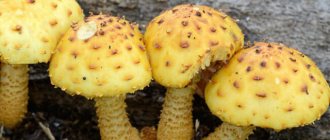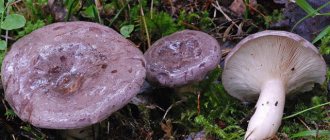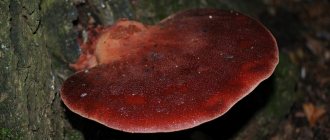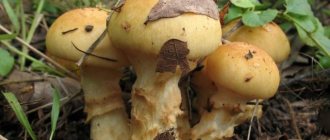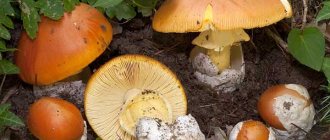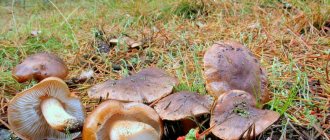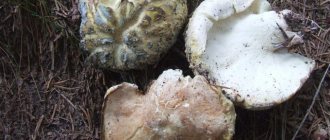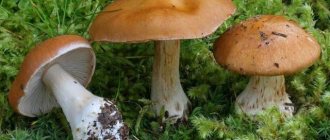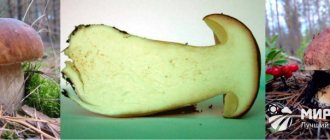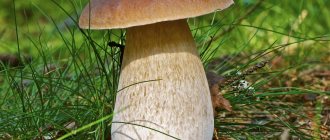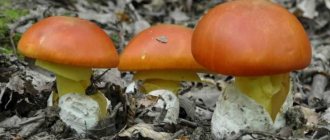It happens that a mushroom picker finds an orange mushroom in the forest and begins to doubt its edibility. Although this color is not so common in the mushroom kingdom, it is not always a sign of a poisonous plant. There are also quite edible orange mushrooms, although they look very exotic. In general, the mushroom map of Russia is very diverse. In some regions you can even find truffles (and this is the most expensive mushroom). But orange mushrooms are much more exotic, although they are not so valued on the world market.
Edibility, description and photo of the mushroom
Orange aleuria (lat. Aleuria aurantia) belongs to the family Pyronemicidae of the order Peciaceae, division Ascomycetes. This mushroom can also be called orange loach, pink-red saucer or orange saucer. In science, it is better known under the names Helvella coccinea, Peziza aurantia, Scodellina aurantiaca.
Aleuria is considered conditionally edible, which means that heat treatment is required before consumption, although you can often see this mushroom as a decoration for salads.
Pecicea does not have a special smell or taste. Its color is very intense - orange, the outer part of the cap is lighter and dull, covered with a light “fluff”.
A young mushroom looks like a pink ball, but as it grows, the cap opens and becomes saucer-like, while the edges remain raised. The size of the cup is usually no more than 4 cm, rarely reaching 8 cm. There are practically no legs, the flesh is white, fragile and thin.
Similar species
Orange aleuria is similar to the following types of mushrooms:
- Hairy melastica or Melastiza chateri
This mushroom is smaller in size, and therefore has no gastronomic value. It has a redder tint to the fruiting body and a fringe of “hairs” along the edges.
- Sarcoscipha scarlet (or bright red)
This fungus grows on a substrate of decaying wood. Found throughout the globe. Various sources note that it is edible and also has medicinal properties. Also used in decorative compositions.
Nutritional properties
The taste of mushrooms is delicate, not very pronounced, and will appeal more to those who prefer exotic dishes. Dried aleuria is good in soups. After cooking it becomes crispy, which is why it has gained popularity among fans.
Overripe mushrooms, as well as those growing near industrial enterprises and highways, are not used for food. Such aleuria can cause harm to the body.
Bludtsevik contains in small quantities:
- vitamins B1 and B2;
- vitamin PP;
- quite a lot of vitamin C.
The calorie content is low, only 22.7 kcal per 100 g, the main part of which is:
- proteins – 2.9 g;
- carbohydrates – 2 g;
- water – 92.8 g.
How, when and where to collect golden aleuria
Golden aleuria is found everywhere. It often grows in open sunny areas. It can be found along roads and paths near forests, in meadows, gardens and even on lawns in parks. The mushroom loves damaged soils and landslide edges; it can grow on old fallen tree branches. Orange aleuria grows in dense groups, sometimes the caps of the mushrooms even grow together.
The mushroom can be found in both coniferous and deciduous forests. For abundant growth, it is important that the summer and autumn are not dry. In places where the sun does not reach, aleuria are small in size, paler in color and watery pulp. It is under the sun's rays that the mushroom caps turn bright orange.
Fruiting begins in early summer and continues almost until the end of October. Peak growth occurs in August. Tender and soft mushrooms can be harvested as early as May. Distribution of limpets: in the Caucasus, Far East, Europe.
The exotic and unique appearance of golden aleuria prevents it from being confused with other types of mushrooms. She has no poisonous counterparts. Other specimens of the genus Aleuria are smaller in size and are very rare. Sarcoscypha can be found in bright red in early spring. However, it differs from orange aleuria in its reddish hue.
Only mushroom caps are eaten. They are carefully cut off with a sharp knife so as not to damage the mycelium. After this, you need to cover it with foliage, then next year you will be able to find orange aleuria in this place again.
You cannot collect overgrown mushrooms, as well as those specimens that grow near highways, railways or industrial enterprises. Such saucers can cause poisoning.
Dense group of orange aleuria (golden)
Use in cooking
The saucer is mainly used to decorate dishes. Mushroom pickers do not often pay attention to the small and bright fungus; they often classify it as poisonous. The recommended cooking time is about half an hour. By frying the saucer, you can preserve its color by reducing the cooking time.
The nutritional value of aleuria belongs to the 4th category, which indicates low value and poor taste.
How to cook stewed saucers in sour cream?
For preparation you will need:
- aleuria – 0.5 kg;
- sour cream – 0.5 l;
- onion – 150 g;
- dill or parsley - half a bunch;
- salt, pepper to taste;
- vegetable oil – 60 ml.
Step-by-step preparation
- Wash the mushrooms in warm water and peel.
- Boil for half an hour.
- Pour out the water and add the mushrooms.
- Fry in a frying pan with added oil until half cooked.
- Add onion, cut into rings, continue frying.
- After three minutes, add sour cream, herbs and simmer for another 15 minutes with the lid closed.
- Finally, season with salt and pepper.
Mashed potatoes, any cereals and fresh vegetable salads are perfect as a side dish.
Making soup
To prepare the first dish of aleuria, you will need dried mushrooms.
Ingredients:
- saucers – 50 g;
- potatoes – 4 pcs.;
- carrots – 1 pc.;
- onion – 1 pc.;
- dill and parsley to taste;
- water – 1.5 l;
- bay leaf – 1 pc.;
- salt and pepper;
- butter – 30 g.
Step-by-step preparation
- Wash the mushrooms with running water and pour boiling water over them.
- Finely chop the onion, grate the carrots and fry in a frying pan with melted butter.
- Chop the aleurias and throw them into boiling water.
- Add potatoes (diced) to the pan after 10 minutes.
- Place the fried onions and carrots into the broth and cook for another third of an hour.
- At the end, add bay leaf, herbs, salt and pepper, cook for a couple more minutes. The soup will taste better if it steeps a little.
Salad recipe
If aleuria is not fried for too long, it can decorate any dish. A warm salad with broccoli and mushrooms can be prepared with bright and beautiful peppers.
Ingredients:
- pasta (horns, shells) – 450 g;
- saucers – 450 g;
- broccoli – 450 g;
- ricotta – 450 g;
- fennel – 1 pc.;
- thyme and red pepper - 1 tsp each;
- lemon zest and chopped garlic - 1 tbsp. l.;
- bell pepper – 1 pc.;
- salt, olive oil.
Step-by-step preparation
- To prepare the salad, you need to boil the mushrooms for half an hour.
- Put the pasta to cook.
- Cook broccoli and fennel until half cooked.
- In a saucepan with oil, sauté finely chopped red pepper and garlic for no longer than 4 minutes. Add citric acid, stirring constantly.
- Place red peppers and mushrooms in a saucepan and continue to simmer for a quarter of an hour.
- Add broccoli, fennel (cut into strips), thyme.
- Place pasta, boiled until half cooked, parsley, salt.
- Remove from heat, cool. Before serving, crumble the ricotta into the salad and sprinkle with herbs.
Such common saffron milk caps
Camelina is another variety of orange mushroom. They are distinguished by their bright orange, even red color. They are highly valued for their taste; some subspecies are even considered a delicacy. Saffron milk caps owe their color to a substance such as beta-carotene, which is converted into beneficial microelements (B vitamins, ascorbic acid, vitamin A).
This family is also rich in mineral salts of iron, magnesium, phosphorus, sodium and even calcium. Moreover, these mushrooms contain a natural antibiotic - lactrioviolin, which is used for inflammatory diseases and is used in complex therapy in the treatment of tuberculosis. Let's talk about some types of these edible orange mushrooms.
Beneficial properties and possible harm for children and adults
Marsupial fungi, which include aleuria, contain chitin, help lower cholesterol and interfere with the absorption of fats in the intestines. Other valuable properties of saucer:
- strengthen gums;
- improve vision;
- help fight obesity;
- help improve immunity;
- reduce stress levels;
- fight viruses, fungal infections and parasites;
- reduce the likelihood of tumor formation.
But there is also a downside to using the mushroom:
- With frequent use, it can cause disruption of the gastrointestinal tract.
- Not recommended for use by patients with pancreatitis, gastritis, peptic ulcers, or liver diseases.
- Prohibited for use by pregnant and lactating women.
- Children under 7 years of age are not recommended to eat.
Excerpt characterizing Aleuria orange
All the young ladies and even the ladies, with the exception of the oldest ones, stood up. Marya Dmitrievna stopped at the door and, from the height of her corpulent body, holding high her fifty-year-old head with gray curls, looked around at the guests and, as if rolling up, slowly straightened the wide sleeves of her dress. Marya Dmitrievna always spoke Russian. “Dear birthday girl with the children,” she said in her loud, thick voice, suppressing all other sounds. “What, you old sinner,” she turned to the count, who was kissing her hand, “tea, are you bored in Moscow?” Is there anywhere to run the dogs? What should we do, father, this is how these birds will grow up...” She pointed to the girls. - Whether you want it or not, you have to look for suitors. - Well, what, my Cossack? (Marya Dmitrievna called Natasha a Cossack) - she said, caressing Natasha with her hand, who approached her hand without fear and cheerfully. – I know that the potion is a girl, but I love her. She took out pear-shaped yakhon earrings from her huge reticule and, giving them to Natasha, who was beaming and blushing for her birthday, immediately turned away from her and turned to Pierre. - Eh, eh! kind! “Come here,” she said in a feignedly quiet and thin voice. - Come on, my dear... And she menacingly rolled up her sleeves even higher. Pierre approached, naively looking at her through his glasses. - Come, come, my dear! I was the only one who told your father the truth when he had a chance, but God commands it to you. She paused. Everyone was silent, waiting for what would happen, and feeling that there was only a preface. - Good, nothing to say! good boy!... The father is lying on his bed, and he is amusing himself, putting the policeman on a bear. It's a shame, father, it's a shame! It would be better to go to war. She turned away and offered her hand to the count, who could hardly restrain himself from laughing. - Well, come to the table, I have tea, is it time? - said Marya Dmitrievna. The count walked ahead with Marya Dmitrievna; then the countess, who was led by a hussar colonel, the right person with whom Nikolai was supposed to catch up with the regiment. Anna Mikhailovna - with Shinshin. Berg shook hands with Vera. A smiling Julie Karagina went with Nikolai to the table. Behind them came other couples, stretching across the entire hall, and behind them, one by one, were children, tutors and governesses. The waiters began to stir, the chairs rattled, music began to play in the choir, and the guests took their seats. The sounds of the count's home music were replaced by the sounds of knives and forks, the chatter of guests, and the quiet steps of waiters. At one end of the table the countess sat at the head. On the right is Marya Dmitrievna, on the left is Anna Mikhailovna and other guests. At the other end sat the count, on the left the hussar colonel, on the right Shinshin and other male guests. On one side of the long table are older young people: Vera next to Berg, Pierre next to Boris; on the other hand - children, tutors and governesses. From behind the crystal, bottles and vases of fruit, the Count looked at his wife and her tall cap with blue ribbons and diligently poured wine for his neighbors, not forgetting himself. The countess also, from behind the pineapples, not forgetting her duties as a housewife, cast significant glances at her husband, whose bald head and face, it seemed to her, were more sharply different from his gray hair in their redness. There was a steady babble on the ladies' end; in the men's room, voices were heard louder and louder, especially the hussar colonel, who ate and drank so much, blushing more and more, that the count was already setting him up as an example to the other guests. Berg, with a gentle smile, spoke to Vera that love is not an earthly, but a heavenly feeling. Boris named his new friend Pierre the guests at the table and exchanged glances with Natasha, who was sitting opposite him. Pierre spoke little, looked at new faces and ate a lot. Starting from two soups, from which he chose a la tortue, [turtle,] and kulebyaki and to hazel grouse, he did not miss a single dish and not a single wine, which the butler mysteriously stuck out in a bottle wrapped in a napkin from behind his neighbor’s shoulder, saying or “drey Madeira", or "Hungarian", or "Rhine wine". He placed the first of the four crystal glasses with the count's monogram that stood in front of each device, and drank with pleasure, looking at the guests with an increasingly pleasant expression. Natasha, sitting opposite him, looked at Boris the way thirteen-year-old girls look at a boy with whom they had just kissed for the first time and with whom they are in love. This same look of hers sometimes turned to Pierre, and under the gaze of this funny, lively girl he wanted to laugh himself, not knowing why.
Artificial cultivation
The mycelium of the rose-red blueberry can be purchased in the store and grown in your garden. A package costs from 130 rubles. The best place for the mushroom will be the base of the tree. Typically the packaging is for 1 sq. m., and the mycelium must be mixed with sand and dry soil before sowing.
The soil for sowing should be dug up 15 cm deep, the excess should be removed, and the mycelium should be distributed over the surface. This area should be covered with humus mixed with soil. Water generously (1 sq. m. – 10 liters of water). Pour the remaining soil on top.
Watering should be done frequently during dry summers; the crop should be harvested twice in the spring and the same amount in the fall. After sowing the mycelium, the first harvest will be no earlier than 2 months later. The mycelium lives as long as the tree exists.
Chanterelles
Chanterelles are a whole family of mushrooms with an orange stem and the same cap. Not all of them are edible, as it might seem at first glance. The following names of mushrooms are considered tasty and nutritious: velvety chanterelle, faceted chanterelle and yellow hedgehog.
The cap of the velvety fox is small, about four to five centimeters. The leg is also small, measuring two to three centimeters. The orange pulp is tender and slightly sour in taste. The fungus settles in acidic soil, mainly among deciduous plants.
The faceted chanterelle is a very beautiful representative of wildlife, with a fibrous fruiting body ranging in size from three to ten centimeters. Forms mycorrhiza with oak and grows from June to October. Poisonous chanterelles include species such as the false chanterelle and olive omphalot, which is found quite rarely, mainly in the Crimea.
